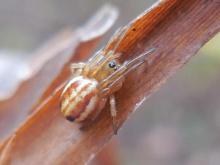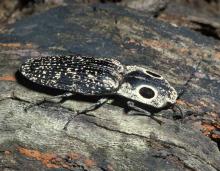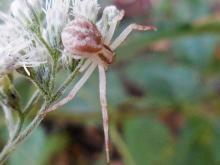Land Invertebrates
Media

Species Types
Scientific Name
Araneus pratensis
Description
The openfield orbweaver is a common nocturnal orb-weaving spider in Missouri.
Media

Species Types
Scientific Name
Araneus marmoreus
Description
The marbled orbweaver is sometimes called the “pumpkin spider” because its rounded abdomen is sometimes bright orange. The color and markings can vary greatly.
Media

Species Types
Scientific Name
Anthrax georgicus
Description
The field coal bee fly, Anthrax georgicus, has no real common name. Look for it in grasslands, fields, and other open areas.
Media

Species Types
Scientific Name
Libellula luctuosa
Description
The widow skimmer has distinctive dark wing markings that seem like mourning garb. Mature males have white areas in the center of their wings, beside the dark patches, while females and immature males lack the white patches.
Media

Species Types
Scientific Name
Libellula pulchella
Description
The twelve-spotted skimmer has twelve brown wing spots. Males, like this one, have eight additional spots that are white. Females lack the white spots.
Media

Species Types
Scientific Name
Alaus oculatus
Description
The eyed click beetle is only one of about 1,000 species of click beetles in North America. Most of the others are drab in comparison.
Media

Species Types
Scientific Name
Mecaphesa asperata
Description
The northern crab spider has many spiny hairs covering the top surfaces of the carapace, abdomen, and legs, and it has usually has greenish-yellow or yellow-brown markings.
Media

Species Types
Scientific Name
Mecaphesa celer (formerly Misumenops celer)
Description
The swift crab spider has many spiny hairs covering the top of its body and legs, and it often has a light pinkish-tan cast.
Media

Species Types
Scientific Name
Misumessus oblongus (formerly Misumenops oblonga)
Description
The green crab spider has spines, and the entire body and legs are pale green to silvery white. Like other crab spiders, its legs extend outward from the sides, and it can walk in any direction.
Media

Species Types
Scientific Name
Acanthoderes quadrigibba
Description
The four-humped flat-faced longhorn has no true common name, but its markings are distinctive. It plays an important role in breaking down rotten wood and enriching soils.
See Also



Media

Species Types
Scientific Name
Cisseps fulvicollis
Description
The yellow-collared scape moth is more often “orange-collared.” And whether you think it looks more like a firefly or a wasp, it’s still a moth!
Media

Species Types
Scientific Name
Nearly 150 species in North America north of Mexico
Description
Slim, delicate plume moths are instantly recognizable by their T-shaped silhouette, long legs, and muted shades of tan and brown. It can be hard to separate the various species.
Media

Species Types
Scientific Name
Pyrrharctia isabella
Description
Not many people know the adult Isabella tiger moth when they see one, but we’re all acquainted with its caterpillar, the woolly worm, or woolly bear.
About Land Invertebrates in Missouri
Invertebrates are animals without backbones, including earthworms, slugs, snails, and arthropods. Arthropods—invertebrates with “jointed legs” — are a group of invertebrates that includes crayfish, shrimp, millipedes, centipedes, mites, spiders, and insects. There may be as many as 10 million species of insects alive on earth today, and they probably constitute more than 90 percent all animal species.





















